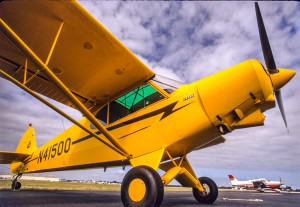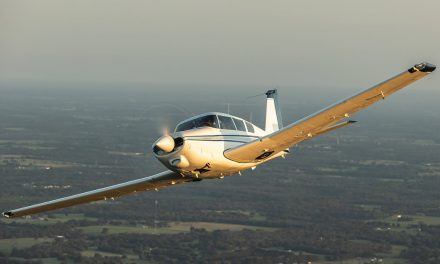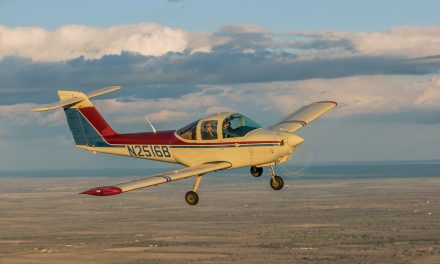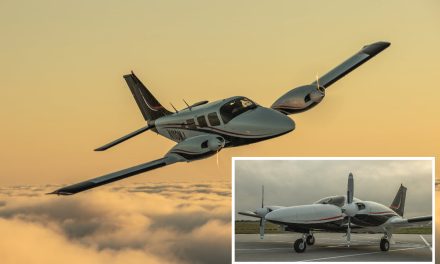 Featured Plane
Featured Plane
A Tale of Two Cubs
Born in the ‘30s when airplanes were simpler and tougher, the Cub became an icon of aviation.
It was both joyous and sad—and totally unexpected. I was in Florida on editorial business when I stopped by Globe Aero, Phil Waldman’s pioneering ferry company in Lakeland. I had made my first 50 international ferry flights for Globe back in the late ‘70s and ‘80s and, though times had changed, Waldman still seemed to always have something interesting parked on the grass out front, either just in from some exotic place or just about to leave.
On this trip, there was a military-painted Grumman Traveler, a then-new, Italian-registered Seneca V headed for Naples, and a pair of Dornier Skyservants fresh from a German surplus sale in Frankfurt.
More significantly, the subject under discussion was a tiny yellow airplane tucked into a hangar—what everyone was calling the “last Super Cub.” It turned out later to be the next-to-last; the absolute last Cub was sold to Stan Monger of Bozeman, Montana. Despite Muncie Aviation’s best efforts to keep the Cub alive (Muncie bought Piper’s entire 1994 production of 24 Super Cubs), Piper had finally thrown in the towel on producing the little fabric-covered aircraft, and this was among the last group of Cubs to roll off the Vero Beach, Florida, production line. Waldman was in the process of completing an export certificate of airworthiness on the airplane, after which it was to be disassembled, containerized, and shipped off to Switzerland.
Ironic, somehow, that one of the last of the most quintessential of American light aircraft was being sold overseas. It was also coincidental that I’d only recently flown the newest Cub’s ancient ancestor, a fully restored, 65-hp Piper L-4 at the late Doug Dullenkopf’s Screaming Eagle Aviation in Santa Paula, California.
The two aircraft were the same, yet different. Both were new, though the 150-hp Super Cub was straight from the factory. Screaming Eagle’s L-4J was probably better than new, one of those remarkable ground-up restorations that can only be considered a tribute to the builder’s tenacity—an airplane that has to be seen to be believed.
Dullenkopf’s L-4, an early 1945 model, actually saw military service in the Pacific near the end of the war, was sold as surplus for $600 in 1947, and redesignated NC68915. It kicked around Northern California for the next 35 years, was rolled over onto its back by a windstorm in the late ‘70s, and abandoned as a derelict until 1982.
That was when Charlie Gerbi of Woodland, California, bought the aircraft and began a restoration that was to demand 10 years of painstaking work. In addition to the dramatic rebuilding effort that included airframe, fabrics, interior, engine, panel, and paint, Gerbi upgraded the L-4 to a Beech Roby controllable-pitch prop—an option never installed on stock L-4s.
In contrast, the new Super Cub had exactly zero options. Waldman’s Swiss model was pure airplane – two wings, tailwheel, engine, and prop, all built around two seats – no ups, no extras. It was deaf, dumb, and IFR blind, with no radios or gyros. Needle, ball, airspeed, altimeter, and compass summarized its flight instrumentation, and $84,900 was its price.
Sitting in the shiny yellow Cub on the ramp at Globe, its Lycoming engine ticking over effortlessly, I couldn’t help but reflect on the history embodied in this friendly, forgiving machine. Born more than six decades before with a mere 20 hp to protect it, the PA-18 sired an entire family of Piper light planes with Pacer, Vagabond, Cruiser, and Clipper monikers. The Cub also indirectly helped make possible thousands more aircraft with names such as Bonanza, Skyhawk, Cherokee, and Malibu.
For me, as for so many thousands of other pilots, the Cub truly represented the beginning. As a 13-year-old CAP cadet in Anchorage, Alaska, I shoveled snow off taxiways, washed airplanes, cleaned hangars, held flashlights, and went for coffee in exchange for chances to fly.
I took my first ride in 1953 in a considerably rattier yellow Cub, flying from Anchorage’s Merrill Field on skis in the depths of winter. Floyd Threet’s 1947 model Piper “Super” Cub, so dubbed because of its upgraded 90-hp Continental engine, was descriptively named “Slow Poke” by the CAP squadron I joined.
Despite so many intervening years, I remember that flight vividly, hunkered into my parka in the back seat as we skimmed low over Alaska’s snow-covered pine forests and frozen lakes, hurtling along at the fearsome speed of 70 mph or 60 knots (whatever those were). In retrospect, I recall the aircraft as a tired and torn bush bird, oil and fuel stained, noisy, and drafty in the -5 degree F air.
Frigid wind leaked in around the ill-fitting doors and windows, and the heater provided no relief at all in the back bucket. Yet, I hardly noticed the fierce cold, the almost physical noise level, and this particular Cub’s general rundown appearance. It never occurred to me that there was risk involved in flying such a ratty machine in the dead of winter. I was truly dazzled by the discovery of flight, and I resolved that someday I’d learn to fly and perhaps even make a decent living as a pilot.
Suddenly, it is 60 years later and I’ve become one of the most enthusiastic student pilots with advanced ratings. Sometimes, I even delude myself into thinking I make a living at it.
The Cub certainly never had doubts about its status though, when it was designed by C.G. Taylor in 1930, it didn’t even have a name. At the time, oil man William T. Piper had only recently acquired Taylor Aircraft. He wasn’t a pilot and knew next to nothing about the airplane business.
When Taylor’s new aircraft made its first brief flight, the elder Mr. Piper’s accountant noted that the model was powered by a 20-hp Brownbach Tiger Kitten engine and made a momentous suggestion: “Why not call the plane the Cub?” Cub it became.
You can consider the Cub either one of the hardest-working business/utility aircraft ever built or the most frivolous toy you could imagine, depending on your point of view. Cubs with horsepower ratings from 20 to 180 have served their owners and the nation well, flying an almost indescribable variety of missions that often couldn’t have been performed by any other airplane.
Though far from the first Cub, the military Piper L-4 Grasshopper was created in 1941 by simply painting a standard Cub green. It was the first of what would eventually become 5600 L-4s, many with special missions and in unique configurations.
With help from Maj. Gen. Hap Arnold and then Col. Dwight D. Eisenhower, William Piper rented a fleet of Cubs to the Army to demonstrate what they could do and, by February of 1942, the first group of 1500 L-4s had been sold. The exploits of those and other L-4 Grasshoppers during World War II are legend that borders on the unbelievable at times.
In fact, a Cub had the dubious distinction of being the first American aircraft fired upon in anger by the Japanese at Pearl Harbor on December 7, 1941. A Honolulu attorney out for an early morning hop over Diamond Head had his yellow Cub riddled with bullets by the first wave of Japanese fighters. Fitted with a greenhouse of Plexiglas out front, in the rear, overhead, and on both sides, the airplanes were highly successful as artillery scouts and could call in a barrage that would wipe out hundreds or even thousands of men and valuable equipment.
Owners of faster, more exotic warbirds often look down their noses at L-4s but, in a very real sense, Grasshoppers could be lethal weapons of war. They first worked as artillery spotters in 1942, participating in the invasion of North Africa at Morocco and Algiers by flying off the deck of the U.S. aircraft carrier Ranger.
Throughout the war in both the European and Pacific theaters, L-4s did any job assigned them without complaint. They delivered ammunition, blood, war correspondents, and generals to the front, transported wounded to the rear, flew photo recon patrols over enemy lines in practically zero-zero weather, dropped hand grenades on enemy troops, knocked out tanks with wing-mounted bazookas and, in a few cases, were actually credited with destroying enemy fighters.
One L-4 suckered an attacking German Me-109 fighter down into a blind canyon in Germany. The slow, maneuverable Cub escaped; the fast Messerschmitt didn’t. Another Grasshopper dueled with a German Fiesler Storch in the last known air combat of World War II. Eventually, the Cub forced the Storch to land, and the Allied pilot took the German aviator prisoner.
When circumstances conspired to down an L-4, it was often repaired on the spot and sometimes back in the air the same day. Though Cubs weren’t indestructible and their slow speed made them good targets, they were hard to bring down. One pilot flew into a cable hanging from a barrage balloon and chopped 18 inches off one wingtip. The airplane flew a little lopsided, but stayed in the air until the pilot finished his artillery spotting mission and returned to base.
The L-4’s primary talents were exactly the opposite of most other aircraft—the smaller the number, the better. Cruise speed was irrelevant and climb rate was less important than climb angle.
In contrast, the powerful Super Cub could manage about 100 mph cruise after a 1000 fpm climb and, with 36 gallons of fuel aboard, pilots could plan on four hours endurance plus reserve. The L-4 noodled along at 70 mph and hardly anyone cared that it only carried 12 gallons in it’s under panel tank.
Cubs were judged more on where they could go than on how fast they could get there. They were STOL machines long before the acronym was coined. The littlest Pipers excelled at flying low and slow and could take off and land practically anywhere.
Even in a still wind, Cubs could jump into the air in a ridiculously short distance and land almost vertically, often with rollouts of less than 100 feet. Throughout World War II and after, the L-4 earned its place as one of the most valuable (if underrated) warplanes in the U.S. inventory.
For those of us not required to fly fighting Cubs, the civilian variety remain a joy of the first order—responsive, willing, and generally easy to fly. Not surprisingly, the 150-hp Super Cub was perhaps the most fun as well as the hardest-working of any PA-18. (A few modified Cubs were used as glider tows and retrofitted with 180-hp Lycoming O-360 engines).
Super Cubs have become THE standard bush plane, used and abused in the hinterlands of the world, flying into places without airports and little more than lat/long coordinates to identify them.
In 40 years of flying, I’ve rarely had more fun in an airplane than at the controls of a Super Cub. Takeoffs can be a kick in a PA-18-150, especially the “jump” variety. Jump takeoffs demand some practice and a definite feel for the aircraft, but the result is worth the effort.
The procedure is simple: line up, push power to the stop against locked brakes, release the brakes, lever the stick forward to raise the tail, pull in full flaps and, simultaneously, rotate hard. If you do it right, the Cub will leap into the air so steeply, the tailwheel will just brush the runway as the nose rotates through 30 degrees up.
As you might imagine, the airplane can’t maintain this steep climb rate forever, and you’ll need to push the nose over and ease off the flaps after a few seconds. Yet, jump takeoffs are a spectacular way to minimize the ground run. With a little practice, you can reduce the takeoff to less then 100 feet.
Stalls in either airplane are akin to practicing a hover in a helicopter. Flying the L-4 in the practice area near Santa Paula, I tried full power-on stalls and watched the airspeed indicator quiver between zero and 20 mph before the aircraft would shudder and enter the stall. Ignoring ASI error, the actual stall was probably 35 mph, but it felt more like five. The SuperCub was similarly slow-mannered. There’s so much power out on the nose and so much wing available, you can fly at what seems like zero airspeed and recover from an inadvertent stall practically instantly.
With such extreme low speed maneuverability at hand, you can’t help feeling at least a little invulnerable in a Cub. Granted any wind at all, you can plan to touch down at groundspeeds well below 30 mph. On the day I flew the L-4, the wind was blowing a solid 15 mph down runway 22 at KSZP, and rollouts from approaches at 45 mph were averaging 200 feet. Crosswinds are an easy matter, one reason the airplanes have been touted as such excellent trainers over the years. Still, as so many pilots have learned over the years, the Cub must be treated with care. After all, it can just barely kill you.
Sadly, it’s probably true that we’ve seen the last of Cub production after 85 years. There’s a lot to love and very little to dislike. Though everyone hates those atrocious heel brakes with which Cubs of all varieties were cursed, most Cubs were converted to toe brakes, and the type rarely needed brakes anyway. And while the airplane remained loud and drafty right up to the end, you’d hardly expect super-soundproofing and comfort in a bush-bird such as this.
In short, the Super Cub represents the end of an era, the last vestige of an age that introduced America and the world to general aviation. It will be missed, but it’s so durable, that will take a while.





